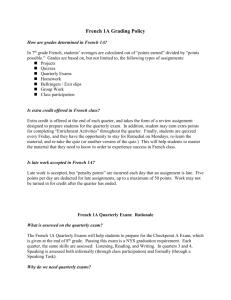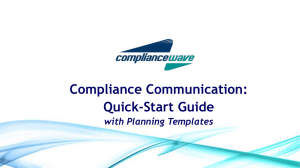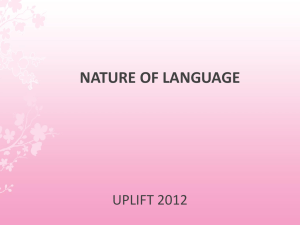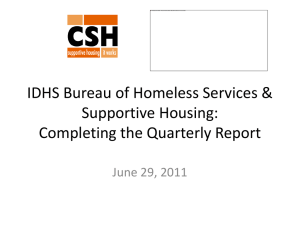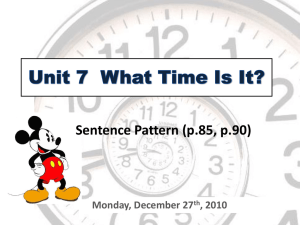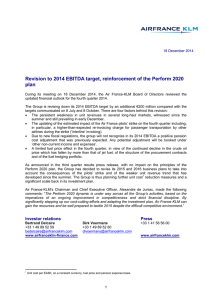TAACCCT Grant Performance Reporting
advertisement
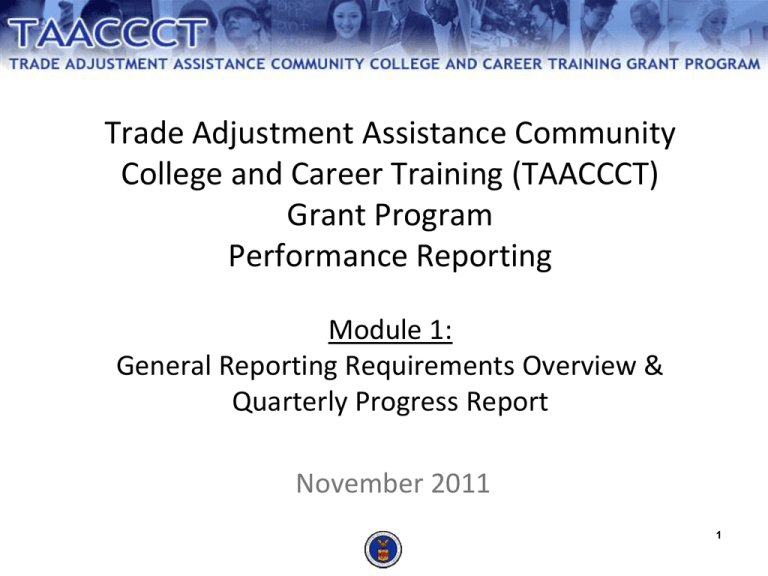
Trade Adjustment Assistance Community College and Career Training (TAACCCT) Grant Program Performance Reporting Module 1: General Reporting Requirements Overview & Quarterly Progress Report November 2011 1 Presenters Hannah Sin, Federal Project Office, Regional Office- San Francisco Megan Baird, Workforce Analyst, Division of Strategic Investments- National Office Kristen Milstead, Workforce Analyst, Division of Strategic Investments- National Office 2 Quick Links The main TAACCCT grant program page is available at www.doleta.gov/taaccct Performance Training Overview Grantees and FPOs will be provided a series of performance trainings consisting of two modules: Module 1: General Reporting Requirements & Quarterly Progress Report Module 2 : Participant and Comparison Cohorts Upcoming performance training for 2012: Annual Performance Reporting General Reporting Requirements Overview 5 Value of Performance & Outcomes Reporting Demonstrating program success to stakeholders (community, Congress, Administration, OMB, GAO, etc.). Demonstrating Grant Outcomes to current investors and partners and building additional strategic partnerships to foster sustainability and growth. Providing program operators and front-line staff with information for decision-making and continuous improvement. Providing DOL with information to ensure program accountability, assist in identifying technical assistance needs and aid program evaluation. Reporting Requirements TAACCCT grantees are required to submit program reports to ETA in order to comply with the reporting and record keeping requirements of the grant These reports are: Quarterly Progress Reports Annual Performance Reports Quarterly Financial Report (ETA-9130 Form) 7 Quarterly Progress Report Each grantee must submit a Quarterly Progress Report (QPR) Status updates on key grant activities in each quarter Updates on the progress and implementation measures specified in each grant Statement of Work Challenges and successes 8 Quarterly Progress Reporting Schedule Calendar Qtr 4 1 2 3 Period Covered Oct 1-Dec 31 Jan 1- Mar 31 Apr 1-Jun 30 Jul 1- Sep 30 Due February 15 May 15 August 14 November 14 *Should the due date of the reports fall on a Saturday or Sunday, the report is due the Friday before. Annual Performance Report Each grantee must submit an Annual Performance Report (APR) Longer-term outcomes of all grant-funded participants Longer-term outcomes of participant cohorts by program and corresponding comparison cohorts 10 Annual Performance Reporting Schedule Year 1 2 3 Period Covered Oct 1, 2011-Sept 30, 2012 Oct 1, 2012-Sept 30, 2013 Oct 1, 2013-Sept 30, 2014 Due Nov 14, 2012 Nov 14, 2013 Nov 14, 2014 *Should the due date of the reports fall on a Saturday or Sunday, the report is due the Friday before. Final Performance & Outcomes Report The last Quarterly Progress and Annual Performance Reports will serve as the grant’s Final Performance and Outcomes Report 12 Key Milestones Grant Start Date: 1st quarterly progress report: Due February 15, 2012 1st annual performance report due: Due February 15, 2012 1st quarterly financial report: October 1, 2011 Due November 14, 2012 Grant End date: September 30, 2014 How Grantees Will Report Reporting tool still under construction Technical instructions will be available on the ETA performance website: www.doleta.gov/performance More communication to follow 14 Performance Reporting & Evaluation Performance reporting as tool for self-evaluation by Grantee DOL-led Evaluation Using data from performance reports for continuous improvement and data-based decision making Grantees may be requested to participate Third-Party Evaluation Grantees must allot funds for independent reviews of deliverables Data Collection, Tracking, and Follow-Up 16 Building Data Collection into Your Existing Processes Decide early (during the start-up phase) which staff members will be responsible for collecting each piece of information based upon their existing roles and relationships with students, how the information will be stored, and how it will be gathered for reporting purposes each year. Determine where Information is gathered and by whom to think through this process 17 Steps in the Reporting Process Collect What information should be collected? Who will collect it? When will it be collected? How will it be collected? Compile Derive counts for each outcome based on participant records Develop report for submission to ETA Check Gut check Double-check numbers entered Look for logical errors 18 Tracking: Phases of Data Collection Intake Demographic Information (Tables 1 and 2) In-Progress All outcomes in Section B of both tables through employment in the quarter after exit (Table 1) or completion (Table 2) Follow-up Employment Retention (Tables 1 and 2) Average Gross Wages (Table 2) 19 Smart Planning for High Outcomes Understanding ETA’s TAACCCT performance measures is not merely a matter of knowing how they are calculated, but of understanding the factors in your program design that might affect calculations! 20 Policies and Procedures are Important to Reporting Although college schedules are typically have fixed start and end dates and completion and exit definitions, there are still procedures that can be implemented to positively affect your outcomes. Utilize intentional program design, where possible! For example, consider the following when determining when to start your cohorts: Participant exit or completion early in a quarter provides more time for a participant to enter employment and be counted in this outcome measure. Employment for any one day in the quarter after the quarter of completion/exit is included in the employment outcome measure. If participants do not retain the same employment after exit/completion, they may be counted as having retained employment if they obtain a different position. 21 Generating Enthusiasm for Performance Reporting: Try this! Use clear, specific instruction regarding data collection so everyone involved knows what is expected. Educate all staff who work with TAACCCT students about the program outcomes and how they are measured. Share your ETA performance numbers with staff and develop internal goals. Track performance regularly and use the data to lead staff discussions and meetings. 22 The Quarterly Progress Report 23 Quarterly Progress Report Provides narrative updates on: Grant management status Resources and partners Capacity building Progress and implementation measures specified in SOW Technical assistance needs Best practices and successes 24 Quarterly Progress Report At the beginning of each QPR, please provide: Grantee Name Project Name Grant Number Report Quarter End Date Date of Submission Program Contact Information 25 Quarterly Progress Report Sections of Report: A. B. C. D. E. F. G. H. Summary of Grant Activities Status Update on Leveraged Resources Status Update on Employer Involvement Timeline for Grant Activities and Deliverables Status of Progress and Implementation Measures Key Issues and Technical Assistance Needs Best Practices, Promising New Strategies and Success Stories Additional Outcome Information 26 Quarterly Progress Report A. Summary of Grant Activities • Narrative executive summary of grant activities for the quarter • • Limited to one page or less Every fourth quarter, should serve as an executive summary of grant activities for the year (including updates from fourth quarter) 27 Quarterly Progress Report B. Status Update on Leveraged Resources • • Description of leveraged resources (Federal and non-Federal, cash and in-kind) as reported in the Financial Status Report (ETA-9130) that were used to support grant activities during the quarter Additional yes/no question: During this quarter, did you receive any additional leveraged resources beyond what is listed in your statement of work? 28 Quarterly Progress Report C. Status Update on Employer Involvement Description of how required employer partners have been involved during the quarter, including the specific roles and contributions of the partner and any challenges encountered. Also, new employers and commitments added to support the project during the quarter. • Additional yes/no questions: • Have you had any consultation or advisory meetings with business or employer partners during this quarter? • Were there any direct hires of program of study completers by employer partners during this quarter? • Were internships or other work-based learning opportunities posted during this quarter? • Did you acquire any additional employer partners during this quarter? 29 Quarterly Progress Report D. Timeline for Grant Activities and Deliverables • Timeline of key activities and deliverables within the quarter as located within the timeline included in the SOW Additional fixed-response questions: • How many programs are you planning to offer? This number should align with your statement of work. • As of this quarter, how many programs have you launched to date? 30 Quarterly Progress Report Suggested tables for displaying progress of activities and deliverables against timeline Suggested Table for Reporting Grant Activities Activity/Task/Milestone/ Event Project Goal State Date Expected End Date Status as of Qtr Ending Date Actual End Date Expected End Date Status as of Qtr Ending Date (i.e. % complete) Actual End Date Suggested Table for Reporting Deliverables ID # Deliverable/Product Description Start Date Quarterly Progress Report E. Status of Progress and Implementation Measures • • Information (numerical or narrative, as appropriate) explaining the status during the quarter of each of the progress and implementation measures specified in the statement of work, including an assessment of the strategies identified in SOW Additional self-assessment for each measure: • Ahead of schedule • On track • Behind schedule 32 Quarterly Progress Report F. Key Issues and Technical Assistance Needs • Summary of any significant issues or problems encountered during the quarter, including actions taken, plans for addressing issues, and assistance requested from DOL 33 Quarterly Progress Report G. Best Practices, Promising New Strategies and Success Stories • Description of promising approaches, innovative processes, and grant-level and or participant/level success stories 34 Quarterly Progress Report H. Additional Outcome Information • Report on any grant-specific outcomes not captured in other sections of the quarterly narrative report or in the Annual Performance Report, including (but not limited to) specific outcomes included in the SOW 35 Contact Information After finishing this recording, submit any questions to the TAACCCT mailbox (taaccct@dol.gov) by COB on December 2, 2011 with subject line: TACT FPO Performance Training Questions. Please copy your FPO. Mark your calendar and join us for a “Live” 60-minute Q&A with ETA Program and Grant office staff to answer your questions 37
